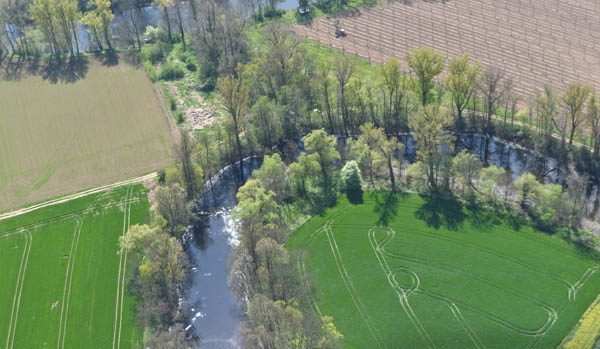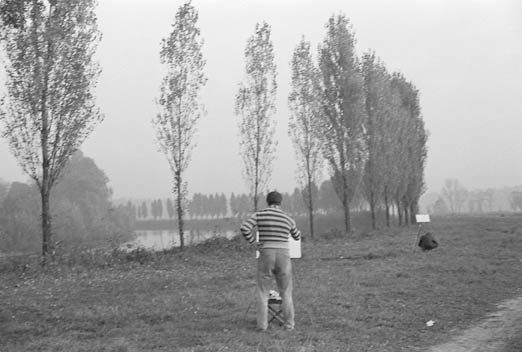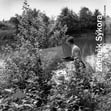texts about zs
The first memorial gathering of friends of painter Zdeněk Sýkora and admirers of his work took place on the banks of the Ohře (Eger) River in Počedělice last July. The meeting was primarily attended by people from Louny, the town where he was born and lived his entire life, but naturally also from Počedělice and nearby villages, some coming on foot and others on bicycle, as well as a large group of friends from Prague and even a number of people from abroad. It was a sunny summer day, clouds floating overhead reflected in the calm river. There was an unusual silence, during which we could hear the birds sing; it was as if time had stood still.... Suddenly everyone could see through the painter’s eyes and became conscious of the scenic beauty of this site. For the first time they also saw a memorial panel here, which was the collaborative effort of Sýkora’s closest friends, Vladimír Hubička and Zdeněk Ziegler, and myself. The panel was unveiled at the service and donated to the village.
Although the idea for a memorial gathering was originally conceived by a handful of people, it was made possible only through the kind support of village officials, especially the Mayor of Počedělice, Eva Smetanová, and assistance from members of the fire brigade, who worked with the Ohře river authority to landscape the river banks and prepare the entire event. Several companies sponsored the installation of the panel and nearby benches, especially Felux Vršovice, CHPS Chomutov, Zinkpower Roudnice and Václav Pastyřík cabinetmakers; the law offices of Jaroslav Trkovský kindly provided legal services to us free of charge. All the sponsors also participated in the Saturday celebration and were certainly rewarded by the enthusiastic reception the event enjoyed by the many who were present and the excellent reviews it received in the local media.
Following the official opening and short speeches, people did not disperse, but rather remained in Počedělice and enjoyed the festive atmosphere that summer afternoon. Some set out to look for motifs from Sýkora’s paintings on both sides of the river, while others engaged in sociable conversation out on the dam or on the village green, having few drinks and enjoying themselves. The concept for the meeting was fulfilled: the central theme was memories. Some recalled Zdeněk Sýkora as a colleague or teacher at the faculty, others as the head of the painting club, a friend from the sauna, ice hockey teammate or next-door neighbour, but mostly as a painter whom they saw out in the countryside with an easel and canvas.
We parted ways late that afternoon, with some already voicing the wish to meet again at the same time next year.

Why this time and this place?
When several friends asked to hold a memorial service to mark the second anniversary since my husband’s death, I started to think about where we should meet. Should it be at a gallery or a museum, as he dedicated his entire life to art and most people knew him as a painter of landscapes, Structures and/or Lines? No exhibitions were scheduled and all the kindred museums that owned his paintings were far away, often beyond the country’s borders. Or should it be at the Faculty of Education in Prague, where he worked for thirty years and passed all his practical and theoretical knowledge on to future generations? Although he also had wonderful experiences at the faculty and is well remembered by his students, after he retired he did not set foot in the art education department building even once and did not respond to invitations. He probably would not have felt very good there. A traditional meeting at the cemetery? He wasn’t particularly fond of them. And is it at all right to commemorate someone who is immortal at a cemetery? I tried to imagine where he would have wanted to meet us. Preferably someplace outdoors, in the countryside, because he felt good in the open space, he liked the water, wind and light. In one interview he explained, “One of the first things that made a strong impression on me as a child was the sight of watching the clouds drift. The horizon also fascinated me – as the place where the landscape ends, and beyond which something continues. The desire for distance is in my genetic code, and I suffer when I’m closed in somewhere.” Elsewhere he said, “Painting outdoors satisfies my need for open space. It is a painter’s form of contemplation and source of power.” This is certainly one of the reasons why he enjoyed landscape painting so much. The most frequent theme in these paintings was his beloved Ohře. He captured the river in every season, and his selection of motifs is worthy of the masters of Impressionism: he always sought out reflections, gleams of light, shadows, clouds, the sky. The paintings chart a magnificent recess in the meandering river and could illustrate the lie of the land of the Louny region or a tour book that would poetically integrate the names of two villages along the river – “From Březno to Pátek” (the Czech literally means “From ‘March’ to ‘Friday’”). In addition to the towns already mentioned, other locations along the Ohře also figure as a theme in Sýkora’s paintings – Lenešice, Dobroměřice, Lužerady, Černčice, Vršovice, Obora, Loužek, Počedělice, Orasice, Kystra and of course his hometown of Louny. But there is one motif that is found most often on his landscape paintings, and that is the Ohře in Počedělice. He rode out here with a painting canvas and easel as early as in the late 1940s, as seen in the names of several canvases presented in the catalogue for Sýkora’s first solo exhibition at Umělecká beseda’s Aleš Hall in Prague in 1952. We were still riding out here together in the 80s and 90s. This was one of his favourite places; he always felt good here. So the question of where we would meet was answered: Počedělice. While planning the memorial afternoon we came up with the idea to invite everyone whom we believed would be happy going to such a meeting and to mark the site with a memorial panel, thus informing the general public about several aspects of the artist’s life and work. Once again I faced a dilemma – which of the several sites in Počedělice where Zdeněk Sýkora painted should I choose? The small clearing tucked away between the trees, or a meadow along the river’s edge from where one could see the most frequently painted Ohře motif in Počedělice very well – the view downstream, where the right side of the painting showed a flat field in the foreground and colourful clusters of bushes and trees in the background, with the tops of the poplar trees behind the bridge also often visible, houses from the village glistening through in the left, the river in the centre in which everything is reflected, including the sky, of course, which takes on dozens of different appearances depending on the time of day and the season. Both sites are located on the right bank of the Ohře and are a bit more distant from the village, thus offering complete silence to focus on work, especially for the Louny painting club, which Zdeněk Sýkora led from 1960. For twenty years a group of young beginning artists rode out here with him, and to this day many of them recall how they painted here. We often also sought out the romantic clearing in between the trees together in into the 80s and 90s, took visitors out here and swam in the river. These days, however, both of these sites are hard to reach and the overgrown brush along the banks make it impossible to paint or swim here.
We could have also chosen a site on the right bank to install the panel, on a path lined with a long alley of poplars, which were also a popular subject in Sýkora’s paintings. Certainly he was thinking about these very trees when he wrote Jindřich Chalupecký about how his work was developing in 1980. “I immediately started to make my first serialist painting (Grey Structure) with an as yet unknown sense of excitement. As the completion of the painting neared, it was clear to me that something very important for me had happened. At times I was terrified at just how far I had gone. But soon I realised that I was back at the beginning. The leaves rustled in the poplars and the river sparked,” he wrote. This last sentence offers proof of just how deep a mark had been left by the feeling he often experienced, how important it was for him to not abandon nature and remain in constant contact with it. The poplars are still standing in Počedělice, but after so many years they are enormous, creating a sort of protective fortification around the river, an unbroken colour substance. Perhaps now they would have to be painted in portrait format.
Another option was to meet on the left bank of the Ohře, almost in the village, near the old stone flood protection barrier. Though it is true that only a few paintings from this site exist, at times when we no longer rode out to the countryside to paint and the clearing was no longer accessible, we would sit here and watch the river. In the end we chose this site for the memorial panel for many reasons (one was purely practical – unlike the other sites, this location is in the Počedělice land registry). The panel was supposed to symbolically merge all of Sýkora’s Počedělice motifs, because from the site where it is located one can see as far as both sides and even here one can view everything Sýkora sought and amply found through the painter’s eyes: the diverse shapes of the trees and bushes and their varying colours on the water surface, clouds floating in the sky and in the river, reflections of sunlight on the water.
Many admirers of Sýkora’s work may object that by commemorating his landscape painting so pronouncedly, we are ruining his profile as a representative of abstract and later concrete art, a pioneer in the use of computers in art, a painter of Structures and Lines who earned fame at home and around the world (actually the other way around – first around the world, then at home once it was permitted). But he himself always said, “My sense of the landscape led me to art. I have no reason to abandon it now.” In another interview in 2000 he reemphasised, “I was strongly attracted to landscapes and continue to be to this day. Looking out at rippling fields of grain is something simply magnificent.” In this regard it is no less important to note that there is always (should always be) a path that leads to magna opera, and for Zdeněk Sýkora it was landscape painting that became the foundation; after he had mastered it, he allowed himself to go further. No one else would define it better than he: “My painting started out of love for nature and the art that was before me.” And elsewhere: “Everything was spontaneous. Before I came to Prague, I had a period of Surrealist and Cubist paintings behind me. But at school I started by studying nature and I found out that when I was supposed to paint a bottle, I didn’t know how to do it. I had to go back to the roots. Everything happened in direct contact with specific things. I painted in the open air. From realistic, descriptive painting I shifted to Impressionism. Of my own volition. I liberated colour, I discovered that paint is an independent tool that has its intrinsic language and intrinsic sense, but one through which nature can be interpreted. Thanks to school, I had actually lagged behind. I wrought out my own path, whereas many of my contemporaries promptly accepted a straightforward one. That’s why I ended up somewhere else. Through nature.” Or: “To this day I am glad that I subjected myself to that martyrdom and that I survived, because that was not art school, we did not learn to make pictures; we learned to see.”

Sýkora did not start to paint outdoors until the late 40s. He voluntarily put himself through training that he and his friend Vladislav Mirvald went through over the course of ten years, training in Realist, Impressionist and Fauvist painting modelled on his favourites – from the Barbizon school to Monet, Cézanne, Matisse, Slavíček and Prucha. And while the beloved French Impressionists had their own forest motif inherited from the Barbizon school in Fontainebleau south of Paris, or to the north they had motifs by the Oise River (another meandering river in thick brush, by the way) and painters from the Pont-Aven school occupied a small settlement in Brittany, Louny’s young painters followed their example and found a valley past Brloh and the Ohře. Josef Hlaváček, a native of Louny, aesthetician and friend of both Mirvald and Sýkora who spent twenty years in their midst, recalls, “In the Fifties one could encounter a couple of young men on bicycles on the streets of Louny often, from spring till early winter. They usually had painted or freshly gessoed canvases tied to their backs and carried old satchels full of solvents and paints in the back bicycle carriers. This couple was Vladislav Mirvald and Zdeněk Sýkora. The Ohře river basin and Bohemian Uplands were their Fontainebleau and Barbizon at the same time. Once they even carried a large painting by riding one behind the other and steering with just one hand, with the first one holding the front edge and the second one holding on to the back edge of the painting. I don’t recall what was on the painting, but the size corresponded to the well-known view from the site between the Schwarzenberg brewery and Černčice; to the astonishment of all in attendance, that painting opened Sýkora’s exhibition at the House of Art in Brno, which Jiří Valoch had organised in the latter half of the Eighties. Sýkora called that painting ‘Breughelesque’.”
But Zdeněk Sýkora rode out to paint in the countryside later on as well, when he moved on to creating the flat-colour paintings of the Gardens cycle and from there arrived at geometric abstraction, Structures in 1962 and Lines in 1973. Painting outdoors constantly examines the senses of every artist; once again they must look for a new motif, carefully look, investigate the forms and colours, notice the lights, shadows, and the sun, occupy the right spot, concentrate on the work and “think with the picture”. Zdeněk Sýkora took this painting very seriously and did not like it when people talked while they worked. He thought about every brushstroke; for him, painting was a joy, not a routine, which is why every painting is different – even when he sometimes painted dozens on the same theme, as he did right in Počedělice.
But few art experts know that even this landscape underwent certain changes and in the early 80s Zdeněk Sýkora once again faced the question of whether they should be further radicalised towards abstraction. In an interview with Vítek Čapek in the early 80s, he expressed it thusly: “Lately, the paintings I paint outdoors have their own structure, even though they respect the initial feeling. I am shifting their form towards ever greater synthesis and simplicity. Now they are reduced only to the horizon line as the border where the substance of the earth makes contact with the substance of space. This is a process similar to the transition from Macrostructures to Lines. In both my ‘rational’ and ‘intuitive’ methods, I unexpectedly arrived at lines as the main feature of expression. Each method strives, in its own fashion, to concretize one and the same feeling of reality.”
When I was thinking about the introduction for last year’s unveiling of the panel, I recalled our pre-wedding trip to France and the several hundred kilometre ride to the city of Aix-en-Provence. We wanted to visit the studio of the revered French painter Paul Cézanne and then see the most frequent motif in his paintings with our own eyes – Montagne Sainte-Victoire, which he must have painted two hundred times. Back then no one in Aix knew where his native home was, everywhere there were just signs pointing to Museum Vasarely. After a long search we finally found the little house with a studio. Thanks to an American foundation, the house was saved in the 50s and various objects associated with Cézanne remained intact. We also discovered the way to the mountain, because Sýkora knew the lay of the land very well from literature and Cézanne’s paintings. We climbed up to the horizon and suddenly it appeared before us: Sainte-Victoire. Although we weren’t exactly at the site where the painter once painted, and although it wasn’t the same as what we knew from his paintings, Sýkora was immensely happy. His “paying tribute to the mountain” is captured in photographs and symbolically open the catalogue commemorating his ninetieth birthday. Many people know the name of this mountain only thanks to Cézanne’s paintings, and we, too, wanted to see it for ourselves just because of them. So it is entirely possible that one day someone will take a trip to Louny to look for Sýkora’s studio in his hometown and they will want to also see the Ohře and Počedělice, the names of which they will know only because of Zdeněk Sýkora’s paintings.
Transtlation: Elizabeth Spáčilová



